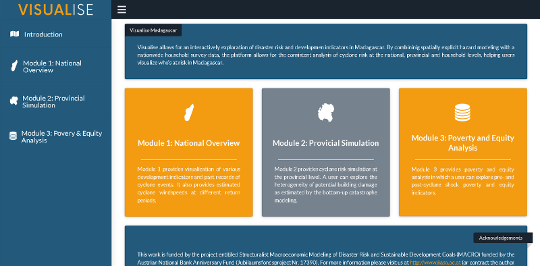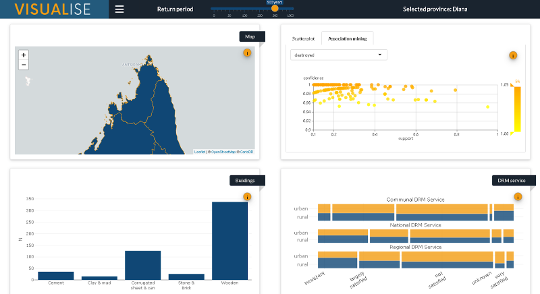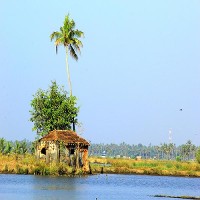Visualise
Disasters triggered by natural hazards such as floods, cyclones and earthquakes are known to affect people in different ways.
People’s choices regarding locations and residence types, occupations and livelihood, as well as other demographic factors, such as age and gender, are known to affect post-disaster recovery. Yet, very few countries globally have standardized ex-ante evaluation methods to explore such disaster risk heterogeneity and the existent vulnerability assessment methods tend to produce ad-hoc results that hinder coordinated disaster risk management efforts at the national and regional levels. Visualise is a new bottom-up catastrophe risk assessment method built on widely available data such as nationwide household surveys and global cyclone wind-speed estimates, which could explore the heterogeneity of disaster risk at different spatial scales. Using an open-source r-shiny platform and various simulation and data-mining techniques,Visualise allows end-users to explore cyclone risk through the following three assessments.


- Module 1 National Overview: provides visualization of various development indicators and past records of cyclone events. It also provides estimated cyclone windspeeds at different return periods.
- Module 2 Provincial Simulation: provides cyclone risk simulation at the provincial level. A user can explore the heterogeneity of potential building damage as estimated by the bottom-up catastrophe modeling and conduct data mining analysis.
- Module 3 Poverty and Equity Analysis: provides poverty and equity analysis in which a user can explore pre- and post-cyclone shock poverty and equity indicators.
Visualise has been developed as part of the Structuralist Macroeconomic Modeling of Disaster Risk and Sustainable Development Goals (MACRO) funded by the Austrian National Bank Anniversary Fund (Jubilaumsfondsproject Nr. 17390) and the platform has now been adopted for Madagascar.
The online interactive platform can be accessed here:
https://visualise-madagascar.shinyapps.io/visualise-madagascar/
Related references
(2019). Reflecting Disaster Risk in Development Indicators. Sustainability 11 (4): e996. DOI:10.3390/su11040996.
Mochizuki J , Keating A, Liu W
, Hochrainer-Stigler S, & Mechler R (2018). An overdue alignment of risk and resilience? A conceptual contribution to community resilience. Disasters 42 (2): 361-391. DOI:10.1111/disa.12239.

PUBLICATIONS
NEWS
"Climate Modernity" - The 24H Challenge: How do we want to live and act in the future in Styria ?
Health fears can increase pandemic isolation habits in older Europeans
How circular waste management systems can benefit the environment
Launch of the Northern African Applied Systems Analysis Centre
How we measure the effects of methane matters for climate policy


